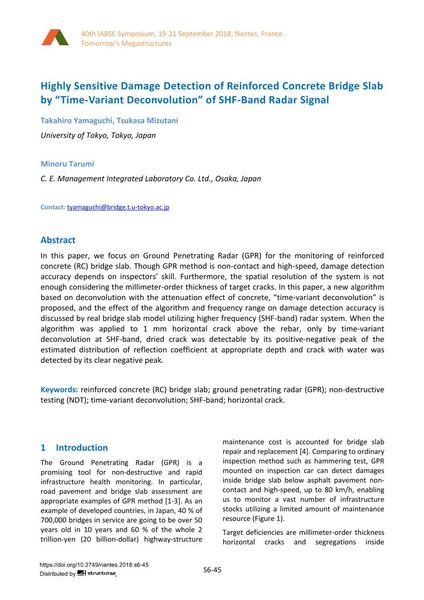Highly Sensitive Damage Detection of Reinforced Concrete Bridge Slab by "Time-Variant Deconvolution" of SHF-Band Radar Signal

|
|
|||||||||||
Bibliografische Angaben
| Autor(en): |
Takahiro Yamaguchi
(University of Tokyo, Tokyo, Japan)
Tsukasa Mizutani (University of Tokyo, Tokyo, Japan) Minoru Tarumi (C. E. Management Integrated Laboratory Co. Ltd., Osaka, Japan) |
||||
|---|---|---|---|---|---|
| Medium: | Tagungsbeitrag | ||||
| Sprache(n): | Englisch | ||||
| Tagung: | IABSE Symposium: Tomorrow’s Megastructures, Nantes, France, 19-21 September 2018 | ||||
| Veröffentlicht in: | IABSE Symposium Nantes 2018 | ||||
|
|||||
| Seite(n): | S6-45 | ||||
| Anzahl der Seiten (im PDF): | 9 | ||||
| DOI: | 10.2749/nantes.2018.s6-45 | ||||
| Abstrakt: |
In this paper, we focus on Ground Penetrating Radar (GPR) for the monitoring of reinforced concrete (RC) bridge slab. Though GPR method is non-contact and high-speed, damage detection accuracy depends on inspectors’ skill. Furthermore, the spatial resolution of the system is not enough considering the millimeter-order thickness of target cracks. In this paper, a new algorithm based on deconvolution with the attenuation effect of concrete, “time-variant deconvolution” is proposed, and the effect of the algorithm and frequency range on damage detection accuracy is discussed by real bridge slab model utilizing higher frequency (SHF-band) radar system. When the algorithm was applied to 1 mm horizontal crack above the rebar, only by time-variant deconvolution at SHF-band, dried crack was detectable by its positive-negative peak of the estimated distribution of reflection coefficient at appropriate depth and crack with water was detected by its clear negative peak. |
||||
| Stichwörter: |
zerstörungsfreie Prüfung
|
||||
